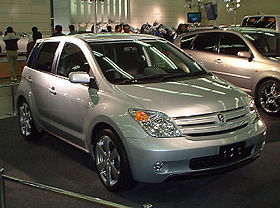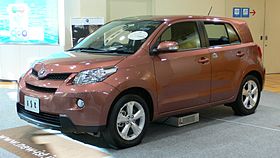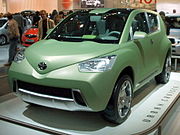Toyota Ist: Difference between revisions
m Bot: Migrating 4 interwiki links, now provided by Wikidata on d:q1818526 |
|||
| Line 33: | Line 33: | ||
Due to the design of the wheel arches, it has been disclosed that installing tire chains is difficult. Toyota's TRD racing development division had initially planned on installing a turbocharger, but plans have not progressed. |
Due to the design of the wheel arches, it has been disclosed that installing tire chains is difficult. Toyota's TRD racing development division had initially planned on installing a turbocharger, but plans have not progressed. |
||
the car has good quality seats, the less fuel consumption makes the car attractive. |
|||
{{Clear}} |
|||
==Second generation== |
==Second generation== |
||
Revision as of 18:48, 16 March 2013

The Toyota ist is a subcompact car made in Japan by Toyota. It is exported to the United States as the Scion xA and Scion xD and to Europe as the Urban Cruiser. The name "ist" is in reference to the suffix term "-ist", which denotes something that adheres to, or is uniquely gifted in a specific talent, doctrine, or ability[1] In Japan, it is available at Toyota dealerships Toyota NETZ and Toyopet Store.
First generation
| Toyota ist; XP60 series | |
|---|---|
 | |
| Overview | |
| Manufacturer | Toyota Kanto Auto Works[2] |
| Also called | Scion xA |
| Production | 2001–2006 |
| Assembly | Iwate, Japan |
| Body and chassis | |
| Class | Subcompact |
| Body style | 5-door hatchback |
| Layout | front wheel drive/AWD |
| Related | Toyota bB Toyota Platz Toyota Vitz Scion xA |
| Powertrain | |
| Engine | 1.3L 2NZ-FE I4 1.5L 1NZ-FE I4 |
| Dimensions | |
| Wheelbase | 2,370 mm (93.3 in) |
| Length | 3,855 mm (151.8 in) |
| Width | 1,695 mm (66.7 in) |
| Height | 1,535 mm (60.4 in) |
| Curb weight | 1,100 kg (2,425.1 lb) |
Based on the first generation Toyota Vitz hatchback, the first generation ist shared a platform with the Toyota Platz sedan.
The ist was developed from the Toyota Vitz supermini in a crossover SUV bodystyle offering the flexibility of larger SUVs, but with the advantage of better fuel economy from a smaller vehicle. It first appeared at the 2001 Tokyo Auto Show, and was placed into production in 2002.
The ist is meant to cater to younger drivers, being sold as a Scion in North America and as the Urban Cruiser in Europe. At its introduction, 42,000 ordered were received in Japan.
Its primary competitor is the Honda Fit and the Nissan March. Popularity of the second generation has dropped off in comparison to the market favorite Honda Fit. The first generation car was used by the Shizuoka Prefectural Police as a police car.
Due to the design of the wheel arches, it has been disclosed that installing tire chains is difficult. Toyota's TRD racing development division had initially planned on installing a turbocharger, but plans have not progressed.
the car has good quality seats, the less fuel consumption makes the car attractive.
Second generation
| Toyota ist; XP110 series | |
|---|---|
 | |
| Overview | |
| Manufacturer | Toyota Kanto Auto Works[2] |
| Also called | Scion xD Toyota Urban Cruiser |
| Production | 2006–present |
| Assembly | Iwate, Japan |
| Body and chassis | |
| Class | Subcompact |
| Body style | 5-door hatchback |
| Layout | front wheel drive/AWD |
| Related | Toyota bB Toyota Platz Toyota Vitz Scion xD Toyota Urban Cruiser |
| Powertrain | |
| Engine | 1.5L 1NZ-FE I4 1.8L 2ZR-FE I4 |
| Dimensions | |
| Wheelbase | 2,460 mm (96.9 in) |
| Length | 3,930 mm (154.7 in) |
| Width | 1,725 mm (67.9 in) |
| Height | 1,540 mm (60.6 in) |
| Curb weight | 1,210 kg (2,667.6 lb) |
The second generation ist is similar to the five-door Toyota Yaris/Vitz; however, unlike the Vitz, the gauges are in front of the driver as opposed to the middle of the dashboard.
This new ist, like its predecessor, is sold as a Scion in the US. But instead of being the new xA, it is called the xD. The only real difference between the ist and xD is a revised front fascia.[3]
In Europe it is sold as the Urban Cruiser with slightly different front panels.[4]
In Japan, the ist is sold as either 4 speed automatic Super ECT for the 2ZR-FE, or as a Super CVT-i for the 1NZ-FE option. One appealing offer for the 1NZ equipped model is the choice of AWD, which was not carried over to the US for the xD.[5] Furthermore, a center console is offered on Japan's ist, but not the US' xD; however, one can easily import center console kits on the internet.
Starting with production model year 2007 in Japan, G-BOOK, a subscription telematics service, is offered as an option.
Urban Cruiser
The Toyota Urban Cruiser is a mini MPV that is currently produced by Japanese automaker Toyota. It was first introduced in 2008 and is still in production. It slots below the Toyota RAV4 to compete against small crossover SUVs like the Nissan Qashqai and Kia Soul, while also attracting buyers of mainstream family hatchbacks. Designed by Toyota ED²,[6] it debuted at the March 2008 Geneva Motor Show and went on sale shortly thereafter.
-
Urban Cruiser prototype at the 2008 Geneva Motor Show
Mechanicals and emissions
The Urban Cruiser is powered by a 1,329 cc petrol engine that produces 100 hp (75 kW) and 132 N⋅m (97 lb⋅ft), as well as a 90 hp (67 kW), 205 N⋅m (151 lb⋅ft) 1,364 cc turbo diesel. Front-wheel drive is standard, but the diesel model is also offered with an all-wheel drive option. Both come with a 6 speed manual transmission. There is no automatic option.
Safety
Despite being equipped with seven airbags, anti-lock brakes and traction control, the car received a relatively poor Euro NCAP safety rating of 3/5 stars.[7]
References
- ^ http://toyota.jp/ist/
- ^ a b "Kanto Auto Works, Ltd". Kanto-aw.co.jp. Retrieved 2010-07-16.
- ^ "new toyota ist". Retrieved July 20, 2007.
- ^ Paul Hudson (2009-07-01). "Toyota Urban Cruiser review". telegraph.co.uk. London. Retrieved 2010-03-01. [dead link]
- ^ "Toyota iSt engine options". Retrieved February 15, 2008.
- ^ Mike Hanlon (2006). "Toyota mini SUV Urban Cruiser concept". gizmag. Retrieved 2011-03-16.
{{cite web}}: Unknown parameter|month=ignored (help) - ^ "Toyota Urban Cruiser's crash test crash". euroNCAP.com. Retrieved 2009-11-26.

